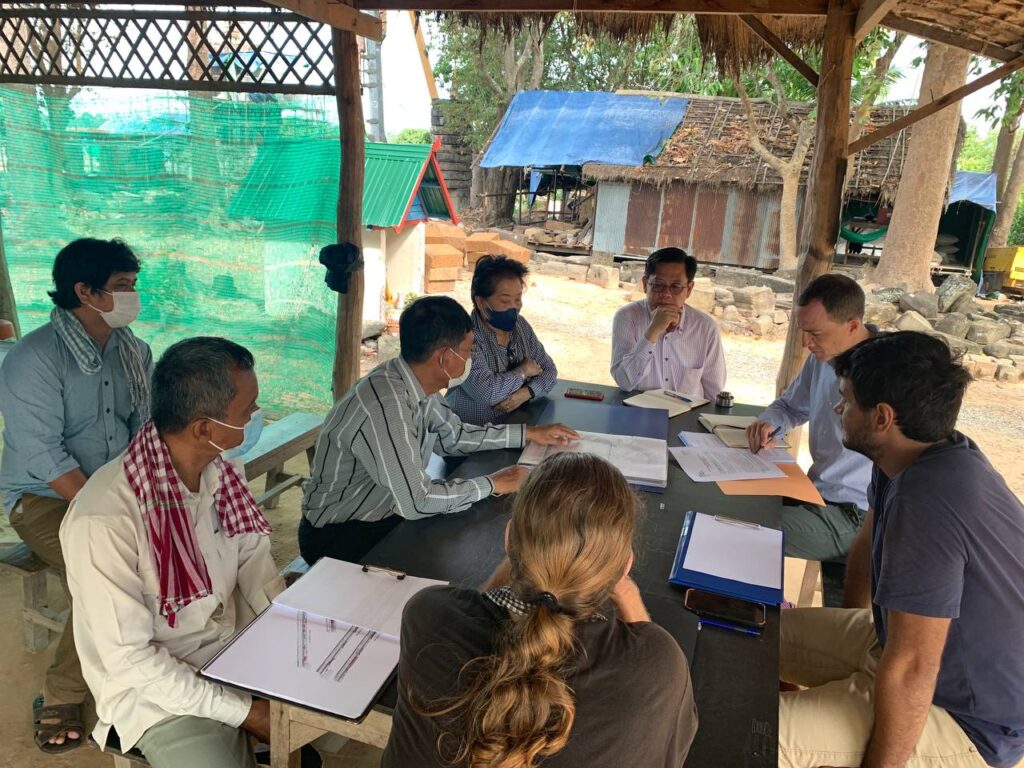រាល់ការជួសជុលសំណង់បុរាណ ដូចជាប្រាសាទកសាងពីថ្មភក់ សំណង់ឥដ្ឋ ឬក៏ថ្មបាយក្រៀមនោះទេ ក្រៅតែពីការធ្វើកំណាយស្រាវជ្រាវ ការពង្រឹងគ្រឹះឡើងវិញ ការស្វែងរកថ្មមកផ្គុំដាក់នៅទីតាំងដើម បំពេញថ្មថ្មីនៅតាមកន្លែងបាត់បង់ ឬខូចខាតដែលចាំបាច់នោះ ការបិទបាយអនៅតាមចន្លោះប្រហោងថ្មដែលខូចខាតឬបាត់បង់ និងនៅតាមមុខតំណក៏ជាកត្តាសំខាន់ដូចគ្នា ដើម្បីការពារការទឹកកុំឱ្យជ្រាបចូលបានតទៅទៀត។
ក្រុមអ្នកជំនាញផ្នែកអភិរក្សសំណង់បុរាណឱ្យដឹងថា រាល់សំណង់បុរាណទាំងឡាយ កាលណាទឹកហូរចូលគឺវាអាចបណ្តាលឱ្យគ្រឹះរបស់សំណង់ឆាប់ចុះខ្សោយ និងឈានដល់ការខូចខាត។ ដោយសារតែមើលឃើញកត្តាសំខាន់នៃការទប់ស្កាត់ទឹកមិនឱ្យជ្រាបចូលរចនាសម្ពន្ធនៃសំណង់នេះហើយ បានជានៅពេលជួសជុលឡើងវិញនូវសំណង់បុរាណនីមួយៗ អ្នកជួសជុលតែងយកចិត្តទុកដាក់បំផុត ទៅលើថ្មមួយចំនួន និងកន្លែងខ្លះ ដែលមិនល្អពេញលេញ១០០ភាគរយនោះ គឺតម្រូវឱ្យបិទបាយអនៅតាមចន្លោះប្រហោងនៅតាមទីតាំងដែលមានបញ្ហាជាចាំបាច់។ ក្រុមអ្នកបច្ចេកទេសឱ្យដឹងថា បិទផ្ជិតបាយអនៅតាមមុខតំណនៃសំណង់ ដើម្បីការពារហានិភ័យទាំងអស់ ដែលអាចកើតឡើង។
កម្មករជំនាញម្នាក់ ដែលមានបទពិសោធន៍ប្រមាណ៧ឆ្នាំហើយ លោក ទក ធុល អាយុ៦១ឆ្នាំមានប្រសាសន៍ថា វត្ថុធាតុដែលអាចយកមកផលិតជាបាយអបាន គឺត្រូវយកម្សៅថ្មបាយក្រៀម ម្សៅឥដ្ឋ កំបោរ និងខ្សាច់លាយជាមួយទឹកទៅតាមសមាសធាតុជាក់ស្តែង។ នៅពេលបិទ ឬបៀកវា ដើម្បីឱ្យជាប់រឹងមាំ គឺត្រូវដាក់ល្បាយកំបោរបាយអដុំគ្រើមៗជាមុន បន្ទាប់មកទើបបៀកកំបោរបាយអម៉ដ្ឋពីលើម្តងបន្តិចៗសង្កត់ឱ្យហាប់ណែនពេញចន្លោះប្រហោងនោះ ទើបមានគុណភាពមិនងាយទឹកជ្រាបចូល ព្រមទាំងមើលទៅមិនទើសទាស់ភ្នែក ព្រមទាំងលើកសោភណ័ភាពសំណង់មួយកម្រិតទៀតផង។
លោក ទក ធុល បញ្ជាក់ទៀតថា លោកធ្លាប់មានបទពិសោធន៍ធ្វើការងារជួសជុលប្រាសាទជាមួយបារាំងជាច្រើនឆ្នាំលើផ្នែកដាប់ឆ្លាក់ក្បាច់ និងលោកទទួលបានចំណេះដឹងផ្នែកផលិតកំបោរបាយអ និងបិទបាយអនេះ នៅច្រាំងកសិន្ធុខាងជើងស្ពានហាលនៃប្រាសាទអង្គរវត្ត បន្តពីអ្នកជំនាញរបស់អាជ្ញាធរជាតិអប្សរា ប្រមាណជា៧ឆ្នាំមកហើយ៕
អត្ថបទ និងរូបភាព៖ យី សុថា
Mortar is important for preventing water from seeping into temple foundations and damaging ancient structures.
All restoration of ancient structures, such as sandstone, brick, or laterite temples, besides the excavations, enhancing the foundations, finding and assembling stones, as well as replacing lost or damaged areas, filling the mortar to the gaps between the damaged or lost stone holes, and the stone joints is also an important factor to prevent water from seeping into the structures.
Experts in the field of ancient structure conservation confirmed that when all the ancient structures got water seeped, it could cause an unstable foundation and lead to damage. Seeing the importance of preventing water from seeping into the structure, when renovating each ancient structure, the restoration team always pays the most attention to some stones and some bad condition places that are required to necessary fill the mortar to the gaps. Technicians say to seal the stone joints of the construction to prevent any possible risks.
61-year-old Tok Thul, A skilled restoration worker, said that the raw materials for the mortar production, include sand, sandstone powder, brick powder, lime, water, etc. To fill the mortar correctly, we needed to apply a mixture of coarse lime mortar first, then use a small amount of lime mortar on top, pressing it tightly to fill the gap so that we got a good quality result to prevent water from seeping. Both look unobtrusive and enhance the aesthetics of the structures.
Mr. Tok Thul added that he had many years of experience in repairing temples with the French team in the field of carving and he also gained knowledge in the production of lime mortar and how to use it to fill the gaps at the Angkor Wat’s embankment from the experts of APSARA National Authority for about seven years.
Article and Photos: Yi Sotha
Share:
Our Latest News

អាជ្ញាធរជាតិអប្សរា រៀបចំកម្មវិធីបណ្ដុះគំនិតកុមារចេះថែរក្សាបរិស្ថានក្នុងតំបន់អង្គរ- APSARA National Authority organizes an environmental training program for children in the Angkor site- 29 May 2025
ថ្ងៃទី២៩ ខែឧសភា ឆ្នាំ២០២៥ អង្គភាពប្រព័ន្ធគ្រប់គ្រងបរិស្ថានអង្គរនៃអាជ្ញាធរជាតិអប្សរា សហការជាមួយសាលាបឋមសិក្សាចំនួន៣ មានសាលាបឋមសិក្សាដូនឪ សាលាបឋមសិក្សាត្រពាំងស្វាយ សាលាបឋមសិក្សាគោកគ្រើល ស្ថិតក្នុងស្រុកអង្គរធំ ខេត្តសៀមរាប




